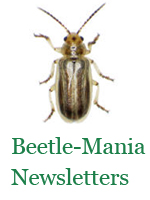Agasicles hygrophila Selman & Vogt
[Coleoptera: Chrysomelidae]
The beetle has an average life span of thirty days. Females may lay up to 300 eggs during their life. Both adults and larvae feed on alligatorweed. Eggs are laid in clusters on the leaf surface. The beetle is very sensitive to extreme temperatures, either hot summers or cold winters, which makes their establishment very difficult
Agasicles hygrophila is native of South America, specifically southern Brazil and northern Argentina. In 1963 approval was granted for its importation into the United States and in January of the following year permission was received from California and South Carolina for the release of the beetle. In 1964, the U.S. Army Corps of Engineers released the biological control agent Agasicles hygrophila in California and South Carolina in hopes of controlling alligatorweed. This beetle was so successful that subsequent releases were made in 9 southern states including Texas.
In 1963, Texas had approximately 1,200 acres of alligatorweed-infested waters, however, this number increased significantly to 11,200 acres infested in 1973. During and subsequent to this sharp increase, a number of releases of Agasicles were made in hopes of controlling this weed biologically. This beetle was first introduced into Texas in 1967. Agasicles became widely distributed in the rice growing areas of Texas as a result of a larger release program in 1969 which included releases in Chambers, Jefferson and Orange counties. In 1972 the beetle had also been successfully established in Harris, Liberty and Brazoria counties. Today alligatorweed does not represent a major aquatic weed problem in Texas. Local problems do occur and supplemental releases are recommended occasionally.
Known Release History of Agasicles hygrophila
in Texas
|
Year |
Specimens Released |
# of releases |
Released Sites |
Released By: |
|
1967 |
2,000 |
2 |
Dam B Reservoir
J.D. Murphee Wildlife Area |
USCE
TPWD |
|
1968 |
3,110 |
5 |
Winnie, Tx
Dam B Reservoir J.D. Murphee Wildlife Area A&M Rice Plantation |
USCE
TPWD TAMU |
|
1969 |
7,000 |
4 |
Houston Area
Eastern Tx/Beaumont |
Harris Co. Mos.
Private Persons TPWD |
|
1970 |
1,300 |
2 |
J.D. Murphee Wildlife Area
Flint River |
Harris C. Mos
TPWD |
|
1972 |
2,400 |
1 |
Catfish Creek-Trinity River
|
Private Persons
|
|
1983 |
3,000 |
|
Wallisville
J.D. Murphee Wildlife Area |
|
|
1984 |
4,000 |
|
Wallisville
J.D. Murphee Wildlife Area Jones Creek |
|
Agasicles hygrophila is essentially monophagous on alligatorweed.
Relocation procedures for alligatorweed flea beetles are well documented by Waterways Experiment Station. Adults and or egg masses are preferred for release programs. A large number should released at a particular time for a better chance of establishment especially because of the combination of the short life-span and the temperature limits of the beetle. Due to the cold temperatures in certain areas of the state, supplemental populations may have to be reintroduced each year. High temperatures may inhibit reproduction and may also cause local loss of Agasicles populations.
This beetle favors emergent vegetation to feed upon. Foliage growing on the banks of waterways and the terrestrial form are hardly fed upon. Consequently alligatorweed often has a resident terrestrial population even when the flea beetle eliminates the emergent foliage.
In 1963, prior to any release of the beetle, there were 97,000 problem acres of alligatorweed in the United States, however, by 1981 there was less the 1,000 problem acres. In 1964, the first release of Agasicles hygrophila was made in California and South Carolina and since that time a number of releases have been made throughout the southern United States. Obviously the release and establishment of biological agents for the control of alligatorweed has been a huge success.
Alligatorweed flea beetles were controlled and released at Clive Runnells Family Mad Island Marsh Preserve to control alligatorweed in November 1996 and May 1997. Released beetles became established at the preserve and completely defoliated from of this weed in June 1997. The beetles continued to be well established in November 1997 and are contributing to the control of alligator weed on the preserve and surrounding areas. As they continue to migrate into new areas, biocontrol of this weed will provide no cost control to adjacent landowners. (See complete report)
This beetle is a biological control agent for alligatorweed.
Buckingham, G.R., Boucias, D., Theriot, R.F. 1983. Reintroduction of the alligator flea beetle into the United States from Argentina. Journal of Aquatic Plant Management 21, 101-102.
Coulson, J.R. 1977. Biological Control of Alligatorweed, 1959-1972. A review and evaluation. Technical Bulletin, United States Department of Agriculture 1547, 98

